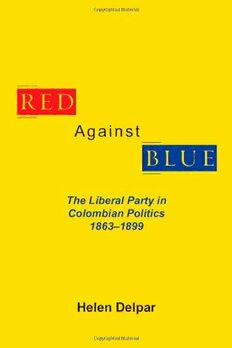
Red Against Blue: The Liberal Party in Colombian Politics, 1863 - 1899 PDF
Preview Red Against Blue: The Liberal Party in Colombian Politics, 1863 - 1899
Red Against Blue ( ( '."' . I '. \'. VENEZUELA 1 '.j (' SANTANDER\ Socorro .... "~'.""" • ; \J' \.."", .,. /,.1 ••_.' ~_....I:L..'/...; BOYACA .',... .Tunja \..', '. (......_.J' Honda .'/.-. I ;--..... J......../ Bogota CUNDINAMARCA '-\ CAUCA COLOMBIA, \ 1861-1903 ......... ....... ~ ECUADOR Red Against Blue The Liberal Party in Colombian Politics 1863-1899 HELEN DELPAR TheUniversityofAlabamaPress Tuscaloosa,Alabama Library ofCongress Cataloging in Publication Data Delpar, Helen. Red against blue. Bibliography: p. Includes index. 1. Partido Liberal (Colombia)-History. 2. Colombia -Politics and government-1863-1885. 3. Colombia Politics and govemment-1886-1903. 4. Partido Con servador (Colombia)-History. I. Title. JL2898.L5D44 329.9'861 79-19081 ISBN978-0-8173-5615-6(pbk. :alk.paper) ISBN978-0-8173-8388-6(electronic) Copyright © 1981 by The University of Alabama Press All rights reserved Manufactured in the United States of America Thisbookwas keyboarded for scannertypesetting byRuth KibbeyandDebbieDavis. To My Parents Contents List of Tables viii Preface ix 1. The Origins of Colombian Liberalism: A Backward Glance 1 2. Party Alignment in Nineteenth-Century Colombia: A Regional Survey 14 3. A Liberal Profile 43 4. The Evolution of Liberal Thought 60 5. The Political Process in a Federal Setting 84 6. The Crisis of Liberalism 110 7. In the Role of the Vanquished 133 8. Road to Revolution 158 Conclusion 185 Notes 192 Bibliography 237 Index 258 Tables 1. Customs Returns for Three Caribbean Ports to the Nearest Peso in Selected Years for the Second Half of the Nineteenth Century 17 2A. Presidential Voting, 1848 and 1856: The Coast 19 2B. Presidential Voting, 1848 and 1856: Four Coastal Cities 20 3A. Presidential Voting, 1848 and 1856: Cauca 24 3B. Presidential Voting, 1848 and 1856: Selected Areas in Cauca 25 4A. Presidential Voting, 1848 and 1856: Cundinamarca and Tolima 30 4B. Presidential Voting, 1848 and 1856: Provinces of Bogota, Neiva, and Mariquita 31 4C. Presidential Voting, 1848 and 1856: Selected Areas in Cundinamarca 32 5. Presidential Voting, 1848 and 1856: Boyaca 34 6. Presidential Voting, 1848 and 1856: Santander 35 7A. Presidential Voting, 1848 and 1856: Antioquia 39 7B. Presidential Voting, 1848 and 1856: Selected Areas in Antioquia 40 8. Rate of Exchange, Colombian Pesos per 100 U.S. Dollars 136 9. Food Prices in Bogota, 1878-1888 138 Preface In 1979 Colombia was the only Latin American country whose political system was dominated by two political parties-the Liberal and the Con servative, associatedwiththe colorsred and blue, respectively-that could trace their origin to the mid-nineteenth century. Elsewhere the political parties born in that era had either disappeared, as in Brazil, or had been reduced to insignificance, as appeared to be the case in Uruguay. Despite, and indeed perhaps because of, their longevity, the Colombian parties were generally viewed negatively by political scientists. Contemporary students of the Colombian parties tend to view them as instruments ofa narrow social elite which possesses most ofthe power and material resources available to Colombian society. This situation is either interpretedapocalypticallyorfatalistically. Intheformercasethe partiesare seen as blindly suppressing the forces of change in Colombian society in order to retain for their masters the inordinate privileges which they have held for generations. The implicit or explicit expectation is that eventually the explosionwillcome andthe traditional partieswillbeconsumedlike the sinners of Sodom and Gomorrah. Other observers, while also seeing the parties as elitist, tend to evaluate thisasoneofthoseinevitable,unpleasantfactsofpoliticallifewhichislikely to go on indefinitely, a culturally determined shackle on the possibilities of economic, social, and political development. Thus the fatalistic observers share with the apocalyptically oriented the conviction that the traditional Colombian party system is on balance pernicious, while they differ in their expectations as to its fate.1 Regardless oftheir overall merit, such value-laden assessments at times hamper understanding of the functions performed by Colombia's parties and of the workings of the party system, about which in reality little is known. Furthermore, existing studies are often weakened by the practice ofsubmittingColombianpartiesandpoliticianstotypologiesmore applica ble to other political systems. Another source ofweakness is the shallow ness of academic knowledge of the Colombian party system. While the work of scholars such as Robert H. Dix, James L. Payne, and Mario Latorre Rueda has provided valuable insights into contemporary politics, analysis of the era before 1930 has barely begun. The Colombian works which deal with nineteenth-century politics are mainly memoirs and biographies, genres which do not lend themselves to theanalysisofentiresystems. Moreover, muchofthe Colombianhistorical writingismarredbyinadequateresearchorbypartisanpassion. Numerous historians in the United States have also explored topics in nineteenth century Colombian history, but only a handful have dealt with primarily political themes.
